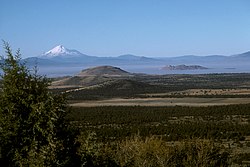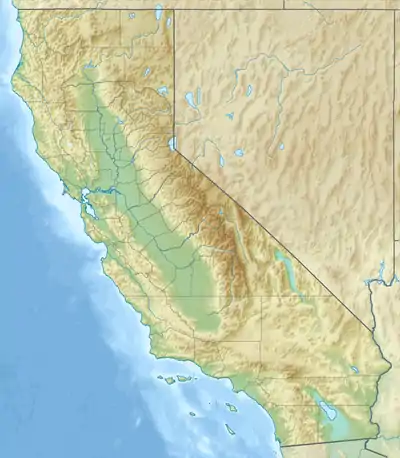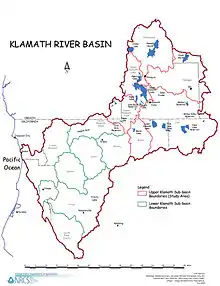Tule Lake
Tule Lake (/ˈtuːliː/ TOO-lee)[2] is an intermittent lake covering an area of 13,000 acres (53 km2), 8.0 km (5.0 mi) long and 4.8 km (3.0 mi) across,[1] in northeastern Siskiyou County and northwestern Modoc County in California, along the border with Oregon.
| Tule Lake | |
|---|---|
 Overview of the Tule Lake Basin | |
 Tule Lake  Tule Lake | |
| Location | Siskiyou / Modoc Counties, California, United States |
| Coordinates | 41.90932°N 121.53305°W[1] |
| Type | Ancient lake, Intermittent lake |
| Primary inflows | Lost River |
| Max. length | 8.0 km (5.0 mi) |
| Max. width | 4.8 km (3.0 mi) |
| Surface area | 13,000 acres (5,300 ha) |
| Surface elevation | 4,035 ft (1,230 m) |
Geography
Tule Lake is fed by the Lost River. The elevation of the lake is 4,035 ft (1,230 m).[1]
It's one of twenty ancient lakes in the world that have existed continuously for more than 1 million years. [3]
Tule Lake is located 2.4 km (1.5 mi),[1] southwest of the town of Tulelake in Northern California.
Wildlife and water
The lake is part of the Tule Lake National Wildlife Refuge and the Klamath Project. Deliveries of water from the Klamath Project have saved wildlife such as ducks. For example, on 24 July, 2020, a delivery of water from the Klamath Project saved 50,000 ducklings from death.[4]
History
Canby's Cross is located about 3 mi (4.8 km) south of the lake; it is the site where General Edward Canby was killed by the Modoc chief Kintpuash, also known to American settlers as Captain Jack.
During World War II, the United States federal government under Executive Order 9066, forced the evacuation of Japanese nationals and Japanese Americans, including citizens born in the United States, to numerous camps built in the interior of California and inland states. They were forced to sell their businesses and homes, and suffered enormous economic and psychological losses by being treated as potential enemies. The Tule Lake War Relocation Center, a Japanese American internment camp, is located east of the lake, in Modoc County. Following World War II, the federal government awarded 86 farm sites on land reclaimed by the drainage of Tule Lake to returning veterans using a Land Lottery.[5] A lottery was used because the number of applicants was greater than the number of homesteads available.[6]
See also
- Klamath Basin
- List of lakes in California
References
- "Tule Lake". Geographic Names Information System. United States Geological Survey. Retrieved Jan 11, 2021.
- pronunciation Tule Lake, OxfordDictionaries.com
- https://web.archive.org/web/20200209063201/https://marine.rutgers.edu/~cfree/ancient-lakes-of-the-world/
- "Klamath water arrives, saving 50,000 ducklings from certain death". SFChronicle.com. 2020-07-24. Retrieved 2020-07-25.
- "Veterans Win Farms at Tule Lake Lottery," Life, 22:73-74, January 20, 1947, referenced in H W Martin and C A McMahan, 'Land Distribution in Georgia, The Southwestern Social Science Quarterly, Vol. 33, No. 1 (June 1952), pp. 44-51
- Klamath Project, "The Klamath Project at 100: Conserving our Resources, Preserving our Heritage" accessed 3 July 2015

